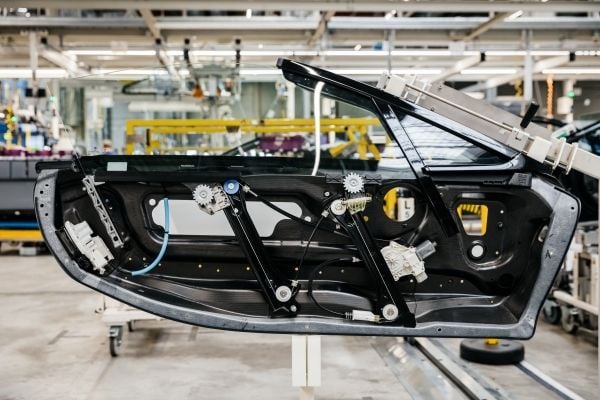![[Image: BMW Group]](https://fabbaloo.com/wp-content/uploads/2020/05/P90329566_lowRes_3d-printed-window-gu_img_5eb0a0319aeed.jpg)
3D printing is prominent in the automotive industry. Automakers are starting to lift the veil on the depth of their investments.
Tooling, jigs and fixtures, customized parts, spare and replacement parts, prototypes, and a rising number of end-use components are 3D printed every day in automotive manufacture. Often regarded as something of a ‘secret sauce’, by now it’s no secret that effectively every major automotive OEM is putting 3D printing to use in its production lines. Many still aren’t willing to reveal the depth of use or talk about specific use cases, but more and more we’re catching glimpses of publicly-available detail in automotive additive manufacturing.
Recently, Ford and BMW both revealed interesting figures underscoring their respective investments into additive manufacturing.
US-based Ford has been putting 3D printing to use for years, with an eye to up-and-coming applications and exploration of 3D printers of all sizes. The company claims early adopter status, having “purchased the third 3D printer ever made in 1988.”
Now the technology will be featuring at the company’s recently-announced new Advanced Manufacturing Center. The $45 million Michigan facility houses 3D printing systems working alongside other advanced technologies. AR, VR, robotics, and digital manufacturing are in focus for the about 100 employees at the facility.
Twenty-three of Ford’s 90 installed 3D printing systems in global operation are housed at the Advanced Manufacturing Center. Ford’s interests in 3D printing include a variety of materials (“from sand to nylon powder to carbon”) and work with ten 3D manufacturing companies.
Operations are relatively expansive, as Ford notes:
“One application currently under development has the potential to save the company more than $2 million.”
And
“There are 3D printed parts in the manufacturing and production of Ford vehicles. The soon-to-be-revealed Shelby Mustang GT500, coming at the North American International Auto Show in January, has two 3D printed brake parts, while the F-150 Raptor built for China includes a 3D printed interior part.”
Another Ford facility, the Michigan Assembly Plant, sees five 3D printed tools used on the line. The company notes that the tools “played a critical role in the launch of Ranger, removing weeks from an already tight timeline.”
From a mass production perspective, Ford has long been a pioneer in adopting cutting-edge workflows. While a century ago this meant an assembly line mentality, today the company is working with 3D printed parts, robots (including collaborative robots, or cobots), and other automation-friendly approaches to automotive manufacture.
“More than 100 years ago, Ford created the moving assembly line, forever changing how vehicles would be mass-produced. Today, we are reinventing tomorrow’s assembly line – tapping technologies once only dreamed of on the big screen – to increase our manufacturing efficiency and quality,” said Ford President of Global Operations Joe Hinrichs.
Another long-standing participant in both automotive manufacture and 3D printing is BMW Group.
Germany-based BMW recently announced a milestone: more than one million parts 3D printed over the last decade. And rising.
The milestone millionth part was a 3D printed window guide rail for the BMW i8 Roadster, produced on an HP MJF system. A showcase component not only for its production number, the guide rail also heralds time savings attributable to 3D printing, having been developed in only five days. The part is now in series production for the i8 Roadster, with up to 100 guide rails being 3D printed in a 24-hour window. It joins an aluminum alloy soft-top attachment fixture as the Roadster’s second 3D printed component.
![[Image: BMW Group]](https://fabbaloo.com/wp-content/uploads/2020/05/P90329562_lowRes_3d-printed-window-gu_img_5eb0a03209997.jpg)
The company continues to experiment with new capabilities for automotive design made possible with advanced technologies and foresees strong growth in activity. BMW notes:
“[T]his year output from the BMW Group Additive Manufacturing Center is expected to reach over 200,000 components — a 42 percent increase on last year’s total.”
BMW stands as a strong example of automotive 3D printing, with use cases continuing to emerge.
“The use of components made by additive manufacturing in series production of vehicles is increasing particularly strongly at the moment. We are following the development and application of advanced these manufacturing methods very closely indeed, partly through longstanding cooperations with leading manufacturers in the field. At the same time, we are engaging in targeted technology scouting and evaluating innovative production systems,” said Dr. Jens Ertel, Director of the BMW Group Additive Manufacturing Center.
There’s certainly much, much more to 3D printing in the automotive industry. Major OEMs of commercial vehicles as well as specialized companies in the racing sector and in advanced supercars are all putting additive manufacturing to use in development, production, and repair.
Ongoing investments and the rise of major production milestones stand as testament to a dynamic application area for advanced manufacturing technologies.

